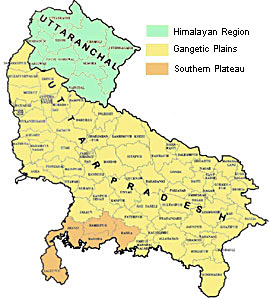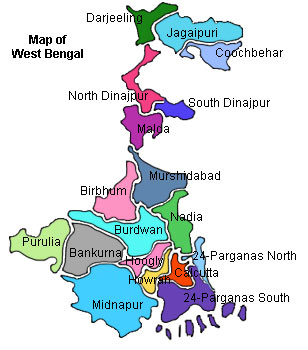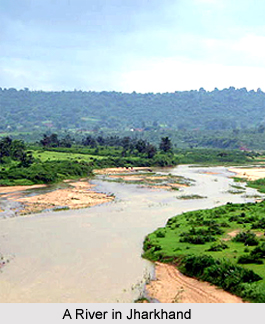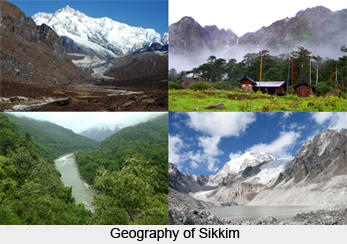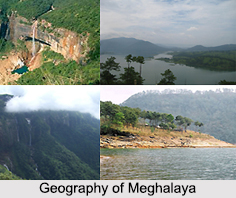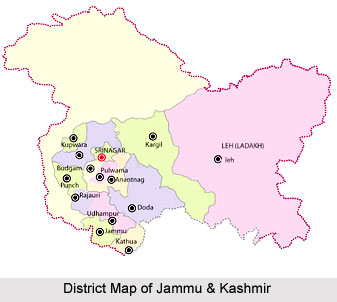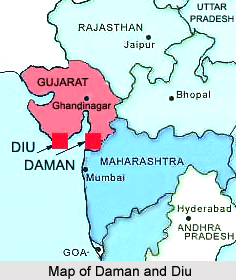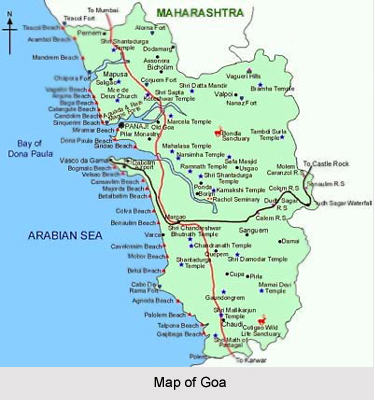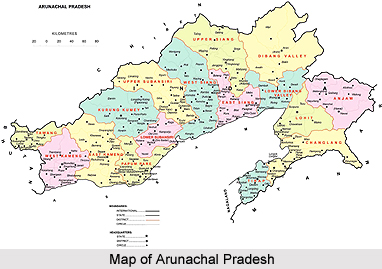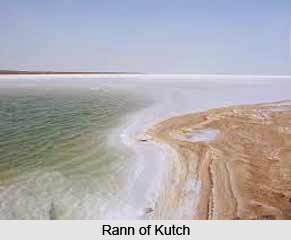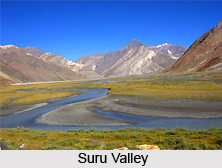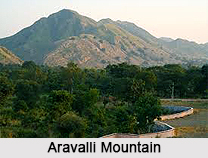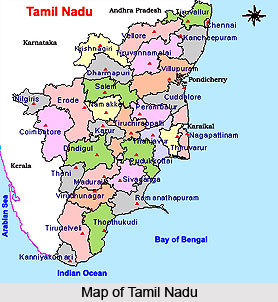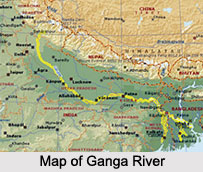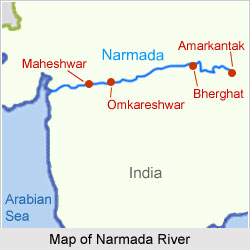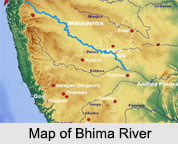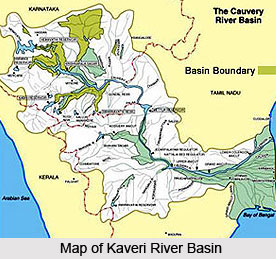About Garhwal Himalaya
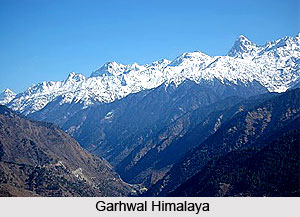 Garhwal Himalaya forms the center part of the Himalaya Mountains. Garhwal is considered as the land of several forts. Garhwal Himalayas symbolizes a spiritual truth beyond the general principles of the common man. This quality has attracted sages and pilgrims for limitless centuries. Central Garhwal consists of the mountain area around the Saraswati-Alaknanda river system and the Dhauli valley. The Dhauli after joining up with the Rishi Ganga (emerging from the protection of the Nanda Devi Sanctuary) eventually joins the Alaknanda at Joshimath. The region is of some considerable significance in Hindu mythology, and Badrinath on the Alaknanda is one of the four holy places of pilgrimage - the others being Kedarnath, Jamnotri and Gangotrii. The exploration and mapping of this region started, as usual, with the survey parties from the Survey of India.
Garhwal Himalaya forms the center part of the Himalaya Mountains. Garhwal is considered as the land of several forts. Garhwal Himalayas symbolizes a spiritual truth beyond the general principles of the common man. This quality has attracted sages and pilgrims for limitless centuries. Central Garhwal consists of the mountain area around the Saraswati-Alaknanda river system and the Dhauli valley. The Dhauli after joining up with the Rishi Ganga (emerging from the protection of the Nanda Devi Sanctuary) eventually joins the Alaknanda at Joshimath. The region is of some considerable significance in Hindu mythology, and Badrinath on the Alaknanda is one of the four holy places of pilgrimage - the others being Kedarnath, Jamnotri and Gangotrii. The exploration and mapping of this region started, as usual, with the survey parties from the Survey of India.
Garhwal is the birthplace of two most holy rivers of Hinduism - Ganga River and the Yamuna River. Moreover, this is the place of the char dhams, which means the four Himalayan shrines that have attracted Hindu pilgrims for centuries. There are several great peaks that rise majestically at the Garhwal Himalaya region like the Kamet, Nanda Devi and Trishul. They are separated by the rivers of northern India. Kamet (7756 m), the prominent point of this area, was surveyed by R. Strachey in the year 1848 and soon after that, climbing attempts began soon after. The Schlagintweits came in 1855 and named the peaks Western, Central and Eastern Ibi Gamin, which are identifiable today as Mukut Parbat (7242 m), Kamet and Abi Gamin (7355 m). Mana (7272 m) was also visited. Between 1910 and 1914 several attempts were made to explore Kamet. Next to Kamet, there lies Abi Gamin that was first climbed in the year 1950 by a team comprising R. Dittert, K. Berril, A. Tissieres and G. Chevally, who approached from the north. Since then, it has been climbed several times.
There were only a few expeditions to Central Garhwal before the 1950s but the major ones did some excellent field work. The first to come was the indomitable Frank Smythe in 1937. He had already visited the Bhyundar valley in 1931 (after the Kamet expedition) and had very appropriately named it The Valley of Flowers, a botanist`s paradise. In the year 1950, a Scottish team under W. H. Murray crossed the Girthi gorge, a tributary of the Dhauli. They trekked in the Siraunch valley and crossed the Unta Dhura (pass) into Kumaon. Apart from climbing some unnamed peaks in the northern rim of the Nanda Devi Sanctuary, they made the first ascent of Uja Tirche (6202 m) and attempted Lampak (6325 m). It was described as an extremely well traveled expedition.
With this expedition the first phase of exploratory climbing was over; the second phase is still in progress where the smaller valleys with challenging peaks of modest height wait to be visited. Meanwhile some of the major ascents in this area have been those of Mukut Parbat (7242 m) by New Zealanders in the year 1951, Hathi Parbat (6727 m) in the year 1963 by an I.T.B.P. team and Ganesh Parbat (6532 m) in the year 1965 by the Indian Police. A word or two on a small selection of peaks to the west of the Saraswati-Alaknanda divide peaks that can be reached from Badrinath on the main road. There are two summits named Avalanche Peak. The first one lies on the Bhagnyu glacier (6196 m) and its avalanche caught early visitors T. H. Tilly and John Jackson in the year 1952.
Nanda Devi, which is a part of the Garhwal Himalayas, is described as the crowning glory of Garhwal. The awe-inspiring peaks, the beautiful valleys and meadows, the strong rivers and the legends aptly describe Garhwal Himalaya.
Western Garhwal Himalaya
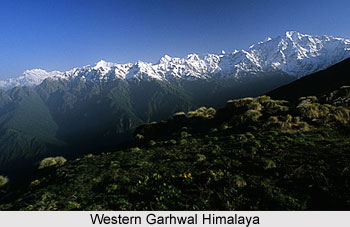 East of the Bhagirathi River is the region of Western Garhwal Himalaya, which is more easily reached from Har-ki-doon and the Tons river. It is considered as a most attractive climbing arena comprising the Swargarohini (I-IV) and the Bandarpunch peaks - White Peak (6102 m), Ban-darpunch (6316 m) and old black peak Kalanag (6387 m). Interestingly, this region first came into prominence when the Doon School masters - R. L. Holdsworth, J. T. M. Gibson, J. A. K. Martyn and Gurdial Singh - used this area to offer climbing experience to their wards during summer holidays. In fact, the first ascent of Bandarpunch in the year 1950 was by Jack Gibson and other young climbers. Since then the Nehru Institute of Mountaineering has taken its students to the area, and they also climbed the peak in the year 1975. Gibson and his boys also made the first ascent of Kalanag in the year 1955. The tradition was continued by Hari Dang (ex-pupil, now master in the Doon School) who led another summit party in the year 1968 to Kalanag, which is regarded as an excellent area for training youngsters to climb and ski.
East of the Bhagirathi River is the region of Western Garhwal Himalaya, which is more easily reached from Har-ki-doon and the Tons river. It is considered as a most attractive climbing arena comprising the Swargarohini (I-IV) and the Bandarpunch peaks - White Peak (6102 m), Ban-darpunch (6316 m) and old black peak Kalanag (6387 m). Interestingly, this region first came into prominence when the Doon School masters - R. L. Holdsworth, J. T. M. Gibson, J. A. K. Martyn and Gurdial Singh - used this area to offer climbing experience to their wards during summer holidays. In fact, the first ascent of Bandarpunch in the year 1950 was by Jack Gibson and other young climbers. Since then the Nehru Institute of Mountaineering has taken its students to the area, and they also climbed the peak in the year 1975. Gibson and his boys also made the first ascent of Kalanag in the year 1955. The tradition was continued by Hari Dang (ex-pupil, now master in the Doon School) who led another summit party in the year 1968 to Kalanag, which is regarded as an excellent area for training youngsters to climb and ski.
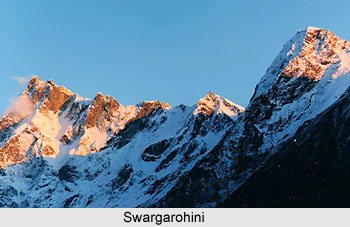 It is not only Swargarohini but all the peaks of the Western Garhwal region are considered beyond the capabilities of beginners. Swargarohini II (6247 m) was climbed by the Canadians (Virk and Clarke) in the year 1974 and again by a Bombay team (Anil Kumar) in the year 1985. Two more Indian ascents were made when a Bombay party (headed by R. Wadalkar) teamed up with an Oil and Natural Gas Commission expedition to reach the top. Swargarohini III (6209 m) was also climbed (its first ascent) by the Bombay party in the year 1985. Swargarohini I (6252 m) is an extremely tough proposition, which is still awaiting its first ascent. Climbing prospects in Western Garhwal region is defined as difficult and impossible. So many peaks in this region of the Himalaya Mountains remain unclimbed merely because they are unnamed and therefore they are of less publicity value. If ever someone just numbers the peaks with their heights one will need to use five figures before the last one is awarded its place. It is said that the keen climber requires little imagination to stoke up the attempt to explore Garhwal.
It is not only Swargarohini but all the peaks of the Western Garhwal region are considered beyond the capabilities of beginners. Swargarohini II (6247 m) was climbed by the Canadians (Virk and Clarke) in the year 1974 and again by a Bombay team (Anil Kumar) in the year 1985. Two more Indian ascents were made when a Bombay party (headed by R. Wadalkar) teamed up with an Oil and Natural Gas Commission expedition to reach the top. Swargarohini III (6209 m) was also climbed (its first ascent) by the Bombay party in the year 1985. Swargarohini I (6252 m) is an extremely tough proposition, which is still awaiting its first ascent. Climbing prospects in Western Garhwal region is defined as difficult and impossible. So many peaks in this region of the Himalaya Mountains remain unclimbed merely because they are unnamed and therefore they are of less publicity value. If ever someone just numbers the peaks with their heights one will need to use five figures before the last one is awarded its place. It is said that the keen climber requires little imagination to stoke up the attempt to explore Garhwal.
Garhwali People
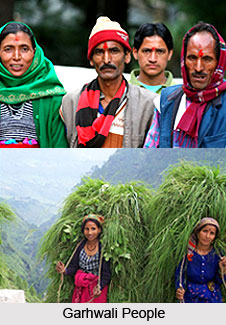 Garhwalis are an Indo-Aryan linguistic group who primarily inhabit the Garhwal Himalayas. Any person who has ancestral Garhwali roots or lives in Garhwal and has a Garhwali heritage is called a Garhwali. Garhwali people are divided into three castes - Garhwali Brahmin, Garhwali Rajput and Shilpkaar.
Garhwalis are an Indo-Aryan linguistic group who primarily inhabit the Garhwal Himalayas. Any person who has ancestral Garhwali roots or lives in Garhwal and has a Garhwali heritage is called a Garhwali. Garhwali people are divided into three castes - Garhwali Brahmin, Garhwali Rajput and Shilpkaar.
History of Garhwali People
The history of Garhwal is older than that of Ramayana and Mahabharata. It is a land of popular myths like Lord Shiva appearing as Karat the Urvashi, the Shakuntala and the Kauravas and Pandavas. The people of this of Garhwal region mainly worship Lord Shiva. The first recorded name of this region was Kartripur. Since it was surrounded on all sides by mountains, it came to be known us "Giri-avil" which, after some time was transformed into Garhwal. Bhanupratap was the first known king and later on his son-in-law, Kanakpal took over. Their kingdom was known as Chandpur-Garhi. King Kanakpal came to Garhwal from Rajasthan from the region Bagerh. He brought with him the Bagerhi language. Therefore, Garhwali and Bagerhi languages are very similar to each other.
Culture of Garhwali People
The culture of Garhwal is an amalgamation of influences from the indigenous population coupled with traditions superimposed by various immigrants who settled in the region from time to time. The unique tribesmen of Garhwal are the Bhotias who are considered to be the mountain climbers. Majority of the people are involved in the agriculture, tourism and the defence industry. Bhotias are different from Tibetans and the resident Hindus; they are worshippers of the peaks of Nanda Devi, Panchchuli etc. Those who are inclined towards Hinduism worships the Gabla God. Other Gods Runiya and Sonia protect their animals from diseases, Sichuan and Bighead gods help them to find their lost animals.
Jaunsari people of Garhwal still practice polyandry (one women married to many brothers). The other tribes are the Doms, Khasias, Nagas, Kinners, Khaikers, Jads, Tangans, Partangans, Bhils, Ban Rajis, Marchyas and Tolchas. Most of these tribes have the youth clubs called `Rang-bangs` where younger people meet and find their well-suited marital partners. After meals, which mainly consist of rice curries, they have tea specially prepared in a bamboo container shaken with a mixture of ground barley and gram, topped with butter. These tribes take alcoholic drinks made from rice. Their main occupation of Garhwal people has been sheep rearing, cultivation and trading, herb collection and hunting.
Marriage Customs of Garhwal
The groom bears the cost of Ganesh Puja followed by a feast. If the groom cannot afford to pay, he either remains unmarried or has to work for his father-in-law. While women do most of the household chores men normally rest. Most of the Garhwali Brahmins and Rajputs are of Khas origin and practice the Khas traditions like "Sautiya baant", "Gharjamain", "Dewar-Bhabhi Vivaah" etc. They are closely related to each other.
The Garhwal Rifles
During the Gurkha War of 1814-1815 AD the Garhwalis were first employed as soldiers in the army. Between 1815 and 1837 AD the Garhwal peoples were employed mainly in the1/5 Regiment of the Gurkhas of Indian Army. In 1880 the first proposal to raise a separate regiment of Garhwalis originated through the Punjab Government and a more tangible recommendation was made in 1886 AD by the Commandeering-Chief in India who wrote that the `Garhwalis would be an excellent fighting class`. The Proposal took its concluding profile on 5th May 1887, when the first regiment was raised. In 1880, this unit took part in Chin-Hill journey and later between 1897 and 1898 saw service in NWFP with the Malakand Field Force and Tirah Expeditionary Force. The present 5th Gurkha regiment had many Garhwalis in its ranks that have continuously proved themselves in times of war.
Art & Painting of Garhwal
The silvery mountains, the gleaming streams, vibrant green valleys and the cool climate have attracted many people to the hills of Garhwal for peace, harmony and meditation. It is this beautiful land, which had encouraged the great writers like Maharishi Valmiki and Kalidas. All this laid the vital foundation for the literary treasures in Garhwal including paintings and art. The art of stone carving slowly died but woodcarving continued. Woodcarving could be seen on every door of the house till only half a century ago. In addition, woodcarving can be seen in hundreds of temple all over Garhwal. The remains of architectural work have been found at the glowing places in Garhwal. Chandpur fort, Temples of Srinagar, Pandukeshwar near Badrinath, Devi Mandir near Joshimath, Deval Garh Temple, all in Garhwal and Chamoli district.
Garhwali Language
 Garhwali is one of the significant languages in the category of the regional languages that has gained recognition in the whole of Indian subcontinent. Garhwali is the major language spoken by the people of Garhwal region. It is integrated to the central Pahari language of the Himalayan region. Large portions of East Himachal Pradesh and Garhwal speak Garhwali. Multitudes of dialects have developed from the Garhwali language. These are namely Jaunsari, Bhotia, Jadhi, Sailani etc. Not only, the Garhwali language influenced numerous languages of India but also enriched by the impact of the other languages in India.
Garhwali is one of the significant languages in the category of the regional languages that has gained recognition in the whole of Indian subcontinent. Garhwali is the major language spoken by the people of Garhwal region. It is integrated to the central Pahari language of the Himalayan region. Large portions of East Himachal Pradesh and Garhwal speak Garhwali. Multitudes of dialects have developed from the Garhwali language. These are namely Jaunsari, Bhotia, Jadhi, Sailani etc. Not only, the Garhwali language influenced numerous languages of India but also enriched by the impact of the other languages in India.
The origin of Garhwali is also quite interesting. Wide influence of Sauraseni Prakrit, which also affected the development of languages like `Rajasthani`, `Brij bhasha` and quite a few `western or central Pahari language` can be traced. Not to mention, Sanskrit and its variants brought about modulations in the Garhwali language.
A famous organization, namely, IMA undertakes a survey in the year 1994 and inferred that total number of Garhwali speakers amounts to 2,081,756.
Folk Songs of Garhwal
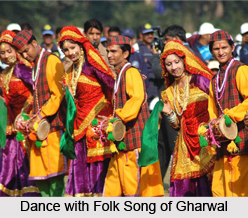 Folk songs of Garwals bring a feel of the typical North Indian essence. The `lok geet` of the region has a mass appeal and makes people fall in love with the tune. The folk music of the region adds to the beauteousness of the Garhwal Division. The folk songs of Garhwal are associated with folk stories, festivals, gods and simple pastoral life of people in the state of Uttarakhand. The folk music of this region is well integrated in every part of the state of Uttarakhand. The `lok geet` of Garhwal has become versatile during the last decade and it has invited a lot of new Garhwali talent to promote the folk songs of the region. The diversity of Garhwali music or Garhwali songs stretches to a large dimension with the areas like martial panwaras, ceremonial mandals and melancholy khuded, thadya and jhoda. Some of the popular folk songs of Garhwal are:
Folk songs of Garwals bring a feel of the typical North Indian essence. The `lok geet` of the region has a mass appeal and makes people fall in love with the tune. The folk music of the region adds to the beauteousness of the Garhwal Division. The folk songs of Garhwal are associated with folk stories, festivals, gods and simple pastoral life of people in the state of Uttarakhand. The folk music of this region is well integrated in every part of the state of Uttarakhand. The `lok geet` of Garhwal has become versatile during the last decade and it has invited a lot of new Garhwali talent to promote the folk songs of the region. The diversity of Garhwali music or Garhwali songs stretches to a large dimension with the areas like martial panwaras, ceremonial mandals and melancholy khuded, thadya and jhoda. Some of the popular folk songs of Garhwal are:
Chhopati - Folk Songs of Garhwal
This particular folk song is popular in the Jaunpur-Rawain area of the Tehri Garhwal. `Chhopati` is actually love songs that are sung between male and female in form of questions and answers.
Chounphula and Jhumeila - Folk Songs of Garhwal
This form of dance, `Chounphula` & Jhumeila`, is a seasonal dance form which take place from `Basant Panchami` to `Sankranti` or `Baisakhi`. The mixed dance form that is restricted to women is Jhumeila, but `Chounphula` is actually a spinning form of a dance that is performed at night, in a group, by people of all community. Chounphula is a dance form which is performed to appreciate the gift of nature. Jhumeila, Chounphula and Daryola folk songs derive their names from the concerned folk dances.
Basanti - Folk Songs of Garhwal
Basanti is a folk song which is, in most cases, sung by individuals or by groups. These songs are mainly composed to welcome the spring season, when flowers bloom and there is a feel of freshness in the valleys of the Garhwal Hills.
Mangal - Folk Songs of Garhwal
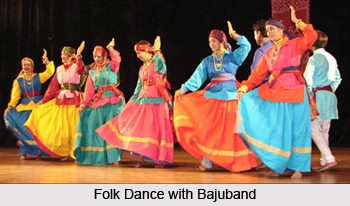 Mangal songs are mainly composed to be sung during puja ceremonies, performed during marriage, to be sung along with the Sanskrit `Shlokas` chanted by the Purohits.
Mangal songs are mainly composed to be sung during puja ceremonies, performed during marriage, to be sung along with the Sanskrit `Shlokas` chanted by the Purohits.
Bajuband - Folk Songs of Garhwal
This particular folk song is concerned with love and sacrifice between shepherds. It is a dialogue of love, sung in the form of `lok geet` or folk song, to be shared between a boy and a girl or a man and a woman.
Jaggar (Jagar) - Folk Songs of Garhwal
This is a form of song which is mainly composed to worship spiritual and ghostly beings. This particular song is accompanied with dances. Sometimes, however, Jaggar can also be in the form of Puja folk songs and are sung in .honour of the various gods and goddesses.
Khuded - Folk Songs of Garhwal
Khuded is a folk song of Garhwal which depicts the sadness and suffering of a woman, caused due to separation from her husband. Here the woman laments the time that she is away from her husband because the man may be out with a job or away from home for some work. `Pawada` also belongs to this category of folk songs where separation is felt when the husband has gone to the battlefield.
Laman - Folk Songs of Garhwal
This is a folk song sung by a man to express his desire to sacrifice for his beloved. Here, through the song, the man expresses his love for his lover and is ready to sacrifice anything to make her feel happy and satisfied.
Chhura - Folk Songs of Garhwal
This is a song popularized by the senior shepherds while giving advice to the young. The lyrics of the songs are mainly deal with teachings or morals. The old people having learnt about life from their experience of grazing sheep and goats pass on the knowledge to the young through songs known as Chhura.
Folk Dances of Garhwal
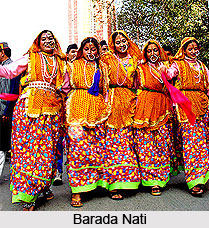 Folk dances of Garhwal are popular in the state of Uttarakhand. Apart from the Folk dance of Kumaon, the Garhwal dance is also quite popular. The main idea behind the Garhwali folk dance is the music and rhythm. The dancers here perform the art in a dynamic manner which is of course in tune with the music. There are various types of folk dances that can be seen in the Garhwal region. Each of the dance form has a unique style and possesses a typical charm. The dances are different for different folk songs. Some of the popular folk dance of Garhwal region is Pandava Nritya, Barada Nati, Langvir Nritya etc.
Folk dances of Garhwal are popular in the state of Uttarakhand. Apart from the Folk dance of Kumaon, the Garhwal dance is also quite popular. The main idea behind the Garhwali folk dance is the music and rhythm. The dancers here perform the art in a dynamic manner which is of course in tune with the music. There are various types of folk dances that can be seen in the Garhwal region. Each of the dance form has a unique style and possesses a typical charm. The dances are different for different folk songs. Some of the popular folk dance of Garhwal region is Pandava Nritya, Barada Nati, Langvir Nritya etc.
Langvir Nritya - Folk Dance of Garhwal
This is a particular dance form which is a typical acrobatic dance and is performed only by men. This is a dance form where a long bamboo is fixed at a particular place. The acrobat dancer climbs to the top of the pole and then balances himself on his stomach perched on the top. Right under that pole there are band of musicians that play `Damana` and `Dhol` while the acrobat dancer performs at the top of the pole. He rotates on the top and performs with his hand and feet. This dance is popular in Tehri Garhwal region.
Barada Nati - Folk Dance of Garhwal
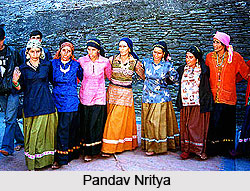 This is a dance that is famous in the region of Jaunsar Bhawar located in the Chakrata Tehsil area in the district of Dehradun. The Barada Nati is a folk dance form which is performed on the religious festivals and also in some of the social functions. This dance is performed by both boys and girls who dress up in traditional but colourful costumes.
This is a dance that is famous in the region of Jaunsar Bhawar located in the Chakrata Tehsil area in the district of Dehradun. The Barada Nati is a folk dance form which is performed on the religious festivals and also in some of the social functions. This dance is performed by both boys and girls who dress up in traditional but colourful costumes.
Pandav Nritya - Folk Dance of Garhwal
This dance form, Pandav Nritya, is associated with the story of Mahabharata and is particularly popular in Garhwal Division of the state of Uttarakhand. This dance is nothing but a straight narration of the episodes from the great epic Mahabharata accompanied with dance and songs. This dance is mostly performed on occasion of `Diwali` and `Dussehra`. This dance form is very popular in the Pauri Garhwal and Chamoli District.
Shotiya Tribal Folk Dances- Folk Dance of Garhwal
This particular dance form is performed by the Shotiya Tribes. The forms of dance include `Dhurang, and Dhuring`. These dance forms are mainly associated with the death of a person. This particular dance form is performed to ensure that the soul of a dead person is liberated, which have been believed to be living in the bodies of animals like goats, cows etc. The dance is similar to the pastorals of Himachal Pradesh or the hunting dance of Nagaland.
Rivers of Garhwal
The holy rivers and Alaknanda (later Ganga) begin from the Garhwal Himalayas and draws off out into the plains of Uttar Pradesh; in addition there are Kali, Ramganga and Yamuna rivers also. The other rivers are Saryu, Pinder, Malini, Hiyul, Rawasian, Khoh and Nayar. All these rivers finally amalgamate into the holy river Ganga.
1. Alaknanda: Alaknanda is formed by the joining together of Vishnu Ganga and Dhauli Ganga at Vishnuprayag originating from the glaciers of Badrinath and Kamet. Vishnu Ganga emerges from Mana pass and the Dhauli originates from Niti pass. The other famous rivers Nandakini originating from Nandadevi glaciers join at Nandprayag, and Pinder originating from the Pindari glaciers in Kumaon joins Alaknanda at Karanprayag and Mandakini joins at Rudraprayag.
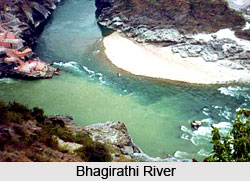 2. Bhagirathi: The holy and renowned river Bhagirathi originates from Gaumukh, the Gangotri glacier in the northern slope of Trisuli peak. The other tributaries e.g. Jadhganga and Bhilanganga join it before Alaknanda River, which joins it at Deoprayag and from they`re onwards the river is decisively called Ganga when it finally moves into the plains at Haridwar.
2. Bhagirathi: The holy and renowned river Bhagirathi originates from Gaumukh, the Gangotri glacier in the northern slope of Trisuli peak. The other tributaries e.g. Jadhganga and Bhilanganga join it before Alaknanda River, which joins it at Deoprayag and from they`re onwards the river is decisively called Ganga when it finally moves into the plains at Haridwar.
3. Western Ramganga: The River originates from the Doodhatoli range in district Pauri Garhwal and enters into district, Nainital before re-entering into district Pauri Garhwal. The river then flows through Patali Dun and then turns southeast before it enters the plains near Kalagarh fort and passes through Moradabad. The other tributaries Mandhul, Palain and Sona also join it.
 4. Eastern Ramganga: Eastern Ramganga emerges from the hills of Nandakot. The other tributaries Jakula and Saryu join it. Thereafter, this river is called Saryu before it joins river Kali, which originates from Milam Glacier in Kumaon region. Eastern and Western Ramganga flow into the plains separately.
4. Eastern Ramganga: Eastern Ramganga emerges from the hills of Nandakot. The other tributaries Jakula and Saryu join it. Thereafter, this river is called Saryu before it joins river Kali, which originates from Milam Glacier in Kumaon region. Eastern and Western Ramganga flow into the plains separately.
5. Yamuna: Yamuna emerges from the Banderpoonch glaciers in district Uttarkashi. A river bag, which flows along the boundary with Himachal Pradesh, west of district Tehri Garhwal, joins Yamuna River at Kalsi and thereafter enters the plains. From Kalsi, the river flows along the boundary with Himachal Pradesh west of district Dehra Dun.
Garhwali Museum
The Garhwali Museum is located at The Garhwal Rifles Regimental Center, Lansdowne. The museum was set up in 1987 to preserve the elements used by the Garhwal Regiment. The museums exhibits Battle scenes of Pre-Independence and Post Independence periods, portraits of the brave soldiers, achievements, customs, traditions, rich certificates and documents of world war I and II, war trophies, antiques, old dresses, medals, appreciation.
The museum is open on all days from 9.00 A.M. to 12.00 noon except on holidays and Sundays.
Trekking in Garhwal Himalayan Region
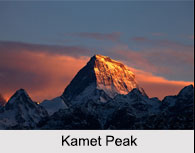 Trekking in Garhwal Himalayan Region of north Indian states is considered as the difficult and challenging. Uttarkhand is a north Indian state where western Garhwal Himalayan Range is present.
Trekking in Garhwal Himalayan Region of north Indian states is considered as the difficult and challenging. Uttarkhand is a north Indian state where western Garhwal Himalayan Range is present.
Garhwal Himalayan Mountain Range in Gharwal Division are the part of Himalayas offer the adventure enthusiast with the activities like high and low altitude trekking, mountaineering, rafting, kayaking, skiing and paragliding.
Location of Garhwal Himalayan Region
Garhwal Himalayan Mountain Range is actually a picture perfect land that is filled with mountain forests and natural valleys that is carpeted with beautiful flowers in the backdrop of clear lakes and majestic waterfalls, picturesque mountains, valleys, meandering rivers, thick forest cover and a wide range of flora and fauna. Garhwal Himalayas are mountain ranges located in Uttarakhand. The mountain ranges cross two regions: Garhwal division and Kumaon division.
Favourable Areas of Trekking
Garhwal Himalayan Region is a tourism destination for adventure sport in India. People from across the country flock the region for a taste of breathtaking adventure. The two most important Himalayan Rivers, Yamuna River and Ganga River (considered as holiest river of India) initiate from the mountains of Garhwal division. Here the trekking to Gangotri group of mountains is popular, which includes the visit to the ancient temples and the archeological sites.
Importance of Rivers for Adventure Sports
The rivers provide the option for river rafting and kayaking. The glacial rivers like Alakananda River and Yamuna River offers the angling, kayaking and river rafting. The trekking expeditions in the Garhwal Mountains are many and this is also an area that has not been explored yet.
Trekking Locations in Garhwal Himalayan Region
Garhwal Himalayan Region has the famous peaks like Kamet peak, Bhagirathi, Dunagiri, Neelkanth, Banderpunch, Trishul and Nanda Devi, which are opt for the difficult treks. Bali Pass Trek, Auden Col Trek, Chopta-Chandrashila Trek, Chandrashila Peak Trek, Bugyal Trek, Dodital Trek, Dodital Bamsaru Khal Pass Trek, Gaumukh Trek, Tapovan Trek, Ruinsara Tal Trek, Kalindikhal Trek, Kedartal Trek, Nanda Devi Sanctuary Trek, Nag Tibba Trek, Roopkund Trek, Satopanth Lake Trek, Shivling Base Camp Trek, Kuari Pass Trek, Valley of Flower Trek, Pindari Glacier Trek, Milam Glacier and Nanda Devi East Base Camp Trek, Vasuki Tal Trek, Khatling Trek, Kedar Kantha Trek and many more.
Trekking in Chandrashila
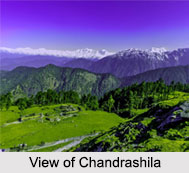 Chandrashila trek in Garhwal division in Uttarakhand is often referred to as Switzerland of India, which offers one of the best experiences for all travelers. Chandrashila, the summit of Tungnath (highest Shiva temple in the World), is located at an elevation of 3,700 meters above the sea level. This peak provides views of the Himalayas, including Nandadevi, Trisul, Kedar Peak, Bandarpunch and Chaukhamba peaks. The entire view of this place is exceptionally picturesque, and appears too good to be true. The region is a protected sanctuary for musk deer, and is rich in flora and fauna.
Chandrashila trek in Garhwal division in Uttarakhand is often referred to as Switzerland of India, which offers one of the best experiences for all travelers. Chandrashila, the summit of Tungnath (highest Shiva temple in the World), is located at an elevation of 3,700 meters above the sea level. This peak provides views of the Himalayas, including Nandadevi, Trisul, Kedar Peak, Bandarpunch and Chaukhamba peaks. The entire view of this place is exceptionally picturesque, and appears too good to be true. The region is a protected sanctuary for musk deer, and is rich in flora and fauna.
History of Chandrashila : The history of this place is associated with several legends, who have spent some time here. One of the legends is Lord Rama. It is believed that Lord Rama meditated here for a long time after defeating the demon king Ravana. Also there is a belief about the visiting of Lord Chandra (the Moon God) here. The word Chandrashila means Moon-Rock.
Chandrashila treks are one of the most popular treks among Indian trekking lovers. The trek to the peak is 5 km. The trek route starts from Chopta and takes one to Tungnath. From there Chandrashila is a kilometer away, and it is a steep trek. Though shorter in distance, steep climbing makes this trek rigorous. Trekking in Chandrashila is well liked by all and is populated round the year except December and January due to heavy snowfall. One can take direct bus from Haridwar or Dehradun to reach Chopta, which is well connected to Garhwal region. Another way to reach Chandrashila is to reach Rudraprayag and follow the route to Kedarnath and then turn right to go to Ukhimath. Chopta is 29 km from Ukhimath.
Dodital Trek in Garhwal
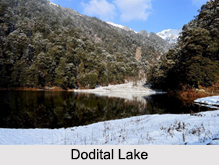 Dodital trek in Garhwal is famous among travelers and is one of the best places for trekkers. High up in the mountain ranges is the Dodital lake which is known for its" mysterious, alluring and mesmerizing scenic beauty.
Dodital trek in Garhwal is famous among travelers and is one of the best places for trekkers. High up in the mountain ranges is the Dodital lake which is known for its" mysterious, alluring and mesmerizing scenic beauty.
Etymology of Dodital : Dodital Lake gets its name from Dodi, the local name for trout fish, which are found in large numbers in the lake.
Dodital Lake, also called Dhundi Tal (Lake of Lord Ganesha) is at an elevation of 3024 meters, north of Uttarkashi, Uttarakhand. The lake is located in the middle of pine forests with the backdrop of Darwa Bugyal, a high altitude pasture. Perfectly clear waters are encompassed by thick oak woods, pine, deodar and rhododendrons. The lake is filled with Brown Trout fish and is likewise known for the Himalayan Golden Trout. The lake is surrounded by a forest which is full of wildlife. Dodital Lake gives a charming set up for rest and recreational exercises like angling, boating and bird watching. The trek from Dodital to Yamunotri Peak takes you through high altitude grasslands and dense virgin forests. The scenery en-route is really astounding.
